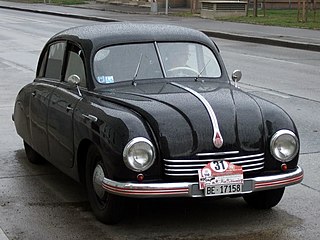
The Tatra 600, named the Tatraplan, was a rear-engined large family car produced from 1948 to 1952 by the Czech manufacturer Tatra. The first prototype was finished in 1946.

Tatra is a Czech vehicle manufacturer from Kopřivnice. It is owned by the TATRA TRUCKS a.s. company, and it is the third oldest company in the world producing motor vehicles with an unbroken history. The company was founded in 1850 as Ignatz Schustala & Cie. In 1890 the company became a joint-stock company and was renamed the Nesselsdorfer Wagenbau-Fabriksgesellschaft. In 1897, the Nesselsdorfer Wagenbau-Fabriksgesellschaft produced the Präsident, which was the first factory-produced automobile with a petrol engine to be made in Central and Eastern Europe. The First Truck was made a year later, in 1898. In 1918, the company was renamed Kopřivnická vozovka a.s., and in 1919 it changed from the Nesselsdorfer marque to the Tatra badge, named after the nearby Tatra Mountains on the Czechoslovak-Polish border.

Hans Ledwinka was an Austrian automobile designer.

Kopřivnice is a town in Nový Jičín District in the Moravian-Silesian Region of the Czech Republic. It has about 22,000 inhabitants. It is an industrial town, known especially for the vehicle manufacturer Tatra.

The Tatra 77 (T77) is one of the first serial-produced, truly aerodynamically-designed automobiles, produced by Czechoslovakian company Tatra from 1934 to 1938. It was developed by Hans Ledwinka and Paul Jaray, the Zeppelin aerodynamic engineer. Launched in 1934, the Tatra 77 is a coach-built automobile, constructed on a platform chassis with a pressed box-section steel backbone rather than Tatra's trademark tubular chassis, and is powered by a 60 horsepower (45 kW) rear-mounted 2.97-litre air-cooled V8 engine, in later series increased to a 75 horsepower (56 kW) 3.4-litre engine. It possessed advanced engineering features, such as overhead valves, hemispherical combustion chambers, a dry sump, fully independent suspension, rear swing axles and extensive use of lightweight magnesium alloy for the engine, transmission, suspension and body. The average drag coefficient of a 1:5 model of Tatra 77 was recorded as 0.2455. The later model T77a, introduced in 1935, has a top speed of over 150 km/h (93 mph) due to its advanced aerodynamic design which delivers an exceptionally low drag coefficient of 0.212. Sources claim that this is the coefficient of a 1:5 scale model, not of the car itself, so the actual drag coefficient may have been slightly higher.
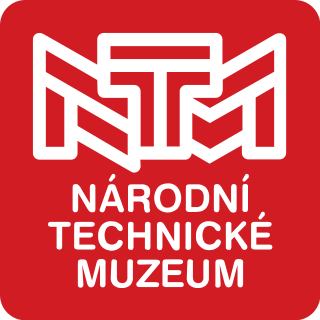
The National Technical Museum (NTM) in Prague is the largest institution dedicated to preserving information and artifacts related to the history of technology in the Czech Republic. The museum has large exhibits representing approximately 15% of its total collection. The museum also manages substantial archives consisting of approximately 3,500 linear shelf meters of archival material and about 250,000 books. The museum was founded in 1908 and has been in its current location since 1941.

The Tatra 87 (T87) is a car built by Czechoslovak manufacturer Tatra from 1936 to 1950. It was powered by a rear-mounted 2.9-litre air-cooled 90-degree overhead cam V8 engine that produced 85 horsepower and could drive the car at nearly 100 mph (160 km/h). It is ranked among the fastest production cars of its time. Competing cars in this class, however, used engines with almost twice the displacement, and with fuel consumption of 20 liters per 100 km. Thanks to its aerodynamic shape, the Tatra 87 had a consumption of just 12.5 litres per 100 km. After the war between 1950 and 1953, T87s were fitted with more-modern 2.5-litre V8 T603 engines.

The Tatra 97 (T97) is a Czechoslovak mid-size car built by Tatra in Kopřivnice, Moravia, from 1936 to 1939.

The Tatra 80 is a Czechoslovak luxury full-size car built by Tatra between 1931 and 1935.

The Austro-Tatra was a car made by Austro-Tatra-Werke, Vienna, from 1934 to 1948.
Julius Mackerle was a Czech inventor and automobile engineer.

The Tatra 12 is an automobile produced by Czech manufacturer Tatra between 1926 and 1933. It was replaced by the Tatra 57 in 1932.

Erich Übelacker was a German automobile engineer.
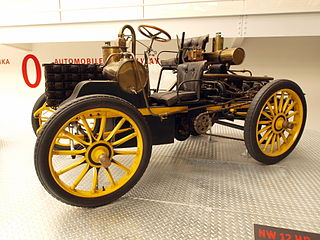
The Double Racer is a race car manufactured by the Nesselsdorfer Wagenbau-Fabriksgesellschaft (NW), now Tatra, in 1900. It is sometimes also called First Racing, 12 HP, or Race Car. It was commissioned by Baron Theodor von Liebieg. Hans Ledwinka, the man behind the famous rear-engined Tatras, and at the time only 20 years old, helped in the production of the car. The car was designed and built in a five week period in April and May 1900. The Rennzweier was the first car designed specifically for racing to be built in Central Europe.
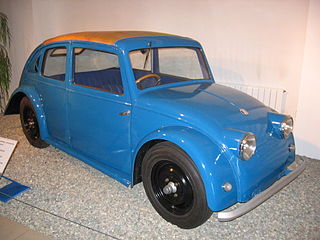
The Tatra V570 was a prototype 1931-33 car developed by a team led by Hans Ledwinka, Erich Ledwinka and Erich Übelacker. The aim of the construction team was to develop a cheap people's car with an aerodynamic body. The first T57-V570 prototype with rear air-cooled two-cylinder engine placed in the former rear luggage compartment of conventional T57 two-seater dropped head coupe was completed late in 1931. However, the company's management decided that the revolutionary ideas introduced in the prototype should be introduced in large luxurious cars, and therefore the team abandoned the project of small cars in favour of the Tatra T77, the world's first serially produced aerodynamic car. The project of a small car was later continued and led to introduction of the Tatra T97. The second, now streamlined V570 four-seater was built in 1933, two years before the first Volkswagen, which bears a strong resemblance to the Tatra – it was misappropriated in the opinion of Tatra, by Adolf Hitler and Dr. Ferdinand Porsche in circumstances about which the German company remains intensely sensitive.
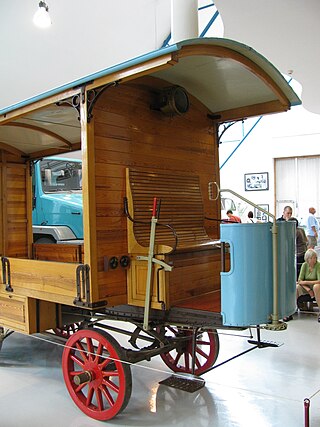
Nesselsdorfer Wagenbau-Fabriks-Gesellschaft (NW) First Truck is an antique truck manufactured by Nesselsdorfer Wagenbau-Fabriks-Gesellschaft A.G. in 1899. A unique feature of the engine setup was that the two engines could be operated sequentially depending on the load requirements. After the company finished its first passenger car, named the Präsident, it focused on manufacturing a truck. The First Truck represents the beginning of the long tradition of Tatra commercial vehicles.
The NW Elektromobil is an automobile from the veteran era manufactured by the Nesselsdorfer Wagenbau-Fabriks-Gesellschaft (NW), now Tatra, from 1900–1901. Only two cars, which were ordered by Emil Kolben's company, Elektrotechnická a. s., based in Vysočany, Prague, were produced. The two Elektromobils had factory numbers 77 and 83.

The Nesselsdorf type B is an automobile from the veteran era manufactured by Nesselsdorfer Wagenbau-Fabriks-Gesellschaft. Initially two cars were made under name Neuer Vierer in year 1901, but later the same car was manufactured under the name type B in 1902 - 1904. In 1904 also another variant of the design was made.
The Nesselsdorf Type C is an automobile from the veteran era manufactured by the Nesselsdorfer Wagenbau-Fabriks-Gesellschaft in 1902. Only two cars of the design were made, and production of the Type C's predecessor, the NW B, continued past that of the Type C (1901–1904).

The NW type S was a series of large automobiles manufactured by Nesselsdorfer Wagenbau-Fabriks-Gesellschaft A.G., in Moravia, in what was then Austria-Hungary.




















